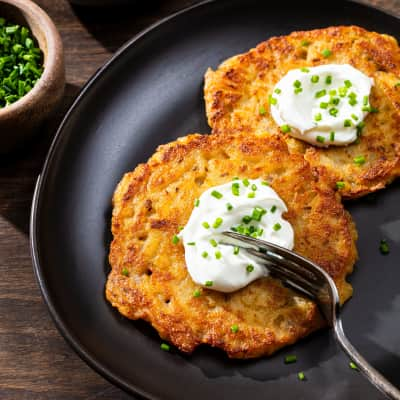Before the Great Famine wiped out Ireland’s monocrop in the late 1840s, the average Irishman reportedly ate a dozen or so pounds of potatoes per day—many simply boiled. So it’s no wonder that cooks got bored and eventually dreamed up alternative ways to serve them.
In counties such as Fermanagh, Cavan, Roscommon, and Leitrim, where boxty scholar Pádraic Óg Gallagher grew up, the predominant innovation was boxty: a potato “bread” in the broadest sense of the word made from grated spuds and sometimes mashed ones as well, plus flour and perhaps a bit of milk or water. The components were mixed to form a dough or batter and then either baked as a loaf, boiled as dumplings, or griddled as pancakes in butter.

<p><em>They’re a mate for almost anything: smoked fish, sausages, rashers, runny eggs, black pudding, corned beef, chicken curry—or just more butter.</em></p>
“It’s a Northwest peculiarity,” said Gallagher, the chef/owner of Gallagher’s Boxty House in Dublin who was reared on the dish. “It doesn’t exist in other parts of the country.”

The griddled version, called pan boxty, is as divine as any potato pancake and remarkably distinct. There’s textural complexity, the densely creamy mash threaded with tender shreds and crisp on both sides, and a buttery richness that oil-fried cakes just don’t have. Pan boxty tastes pure and earthy—and according to Darina Allen, Ireland’s culinary matron, cookbook author, and founder of the Ballymaloe Cookery School in Cork, these potato cakes are “properly delicious” when scented with caraway seeds. And they’re a mate for almost anything: smoked fish, sausages, rashers, runny eggs, black pudding, corned beef, chicken curry—or just more butter.
“Butter is the secret to boxty,” said Gallagher. “When you fry it up, you’ve got to have some really good butter to put on top of it.”
And yet, boxty is unsung compared with Ireland’s more widely established potato dishes such as champ and colcannon. Gallagher means to change that by giving boxty a lift through his restaurant and scholarship (he’s part of an effort advocating for boxty’s Protected Geographical Indication, or PGI, status). So, I hoped, might I. Because who doesn’t love buttery, crispy, creamy potatoes—not to mention, as both Gallagher and Allen pointed out, a simple, nourishing way to use up leftover mash?
Pan Boxty: Best-of-Both-Worlds Potato Cakes

Mashed potato pancakes are rich and creamy; shredded versions are earthy and crisp. Pan boxty, made from a thick batter that typically contains both forms of potato, combines elements of the two styles. Here’s how we prep the spuds.
Mashed: Use leftovers if you’ve got them. If you don’t, cut 1 pound peeled russet potatoes into 1-inch chunks. Cover with water in saucepan and simmer until tender. Drain well and mash or pass through food mill. Stir in 1/2 teaspoon table salt.
Shredded: Grate peeled potatoes on large holes of box grater. Place shreds in clean dish towel and twist tightly over sink to wring out as much liquid as possible.
Batter Up
If there’s a common thread from one boxty to the next, it’s that they’re all made with floury, high-starch potatoes that cook up dry and fluffy, mash easily, and eagerly soak up milk and butter. In Ireland, that might be Roosters or a newer variety called Irish Golds; here, russets are the obvious choice.
Beyond that, the formula is often equal parts peeled, grated raw potatoes that have been squeezed of as much of their liquid as possible; mashed potatoes (leftovers are practical, but a fresh batch works fine, too); and flour. The stiff mixture gets seasoned with salt and pepper and loosened with milk (sometimes buttermilk) or water until it’s fluid enough to spread or pour, and then it’s cooked—either as one large pancake or several smaller ones—in butter over moderate heat until the shreds are tender and both sides have browned and crisped.
It’s an easy ratio to remember, but I doubled the amount of shreds to work in more of their undiluted earthiness and also reduced the flour slightly to allow the potato flavor to come to the fore. Then I added the caraway seeds, per Allen’s suggestion, along with the salt and pepper and loosened everything with milk—more flavorful than water and a source of protein and sugar that would encourage browning.
A Debate Over Boxty’s Backstory

There’s no question that boxty helped relieve the ennui of a largely boiled potato diet, but how it came to be is unclear. Darina Allen, acclaimed cookbook author and chef based in Cork, said that boxty could have evolved during the Great Famine as a way to use up potatoes that weren’t good enough to boil.
“The watery, sometimes even rotting, potato flesh was put into a cloth and squeezed to remove as much liquid as possible,” she wrote in Irish Traditional Cooking (2012). “The remaining pulp was shaped into cakes and baked on a heated flagstone or griddle.”
Boxty scholar and chef/owner of Gallagher’s Boxty House in Dublin, Pádraic Óg Gallagher, acknowledged that many sources point to the dish as famine food—but disagrees. You can’t make boxty with bad potatoes, he said, nor were there any potatoes to extend during the famine. On the contrary, his research points to it as special‑occasion fare.
“[Irish writer] William Carleton described it as a celebratory dish,” Gallagher said, something cooks made “because the priest was coming to the house.”
However boxty evolved, JP McMahon, culinary director of EatGalway and founder and director of the international symposium Food on the Edge, stressed that the dish is deeply regional and that there has never been one set way of making or serving it.
“The recipes would have been quite fluid,” he said, noting that he sometimes adds herbs to the batter and thinks the dish pairs especially well with flavors that balance the starch—such as fermented clotted cream or briny oysters. “I mean, it was all about necessity and what one had.”
Full Steam Ahead
I tried griddling the batter as one big pancake and then slicing it into wedges for sharing, appreciating the single-batch efficiency and visual appeal. But flipping a pancake as big as my 12-inch skillet felt unwieldy, and because it was hard to cook off the moisture from all that batter, the surfaces never crisped up adequately. So I made smaller pancakes: 1/4 cup of batter each, spread into 3½-inch rounds.
I was intentionally precise with those measurements, since portion size and thickness affected how the boxty cooked. The raw potato shreds embedded in thicker pancakes were still chewy by the time the butter in the pan was creeping toward burnt. Plus, thinner boxty meant more surface area for crisping.
Science: Cover Story

Butter is what crisps and browns the pancakes, but a lid is the key to their dense, creamy interiors. Covering the skillet limits evaporative cooling—a phenomenon where water evaporates from the surface of the food, causing it to cool down and prolonging cooking. That way, the raw potato shreds and batter get and stay hotter and cook through faster.
But what really helped the pancakes cook through faster was covering the skillet. Doing so prevented steam, and thus heat, from escaping, which encouraged their centers to soften up quickly. Plus, the batter set and browned more quickly. Within 5 minutes, they were ready to flip and crisp on the second side. To avoid overheating the butter, I started it over a low flame and raised the heat to medium only once I’d added the batter; I also wiped out the skillet and added fresh butter between batches.
I savored the contrast of the pancakes’ crisp exteriors and velvety-soft middles. Allen’s caraway seed recommendation had been spot-on: The citrusy fragrance took the pancakes to another level, as did a fried egg or a few slices of smoked salmon draped over the top. It’s hard to imagine why boxty hasn’t gotten much attention outside of northwestern Ireland—but with any luck, it will now.

Pan Boxty
Pan boxty, from the country’s Northwest, is a buttery, griddled mash-up of mashed and shredded spuds.
Get the Recipe